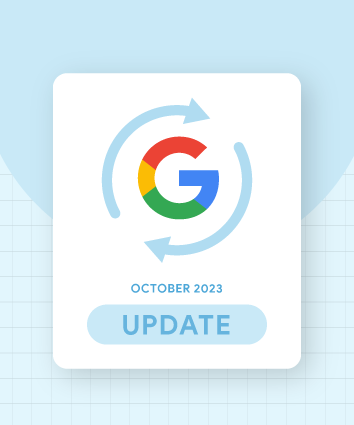What Is B2B Digital Marketing? (Examples & Strategies)

Written by Nevil Bhatt
19 min read

Before we jump to any discussion – Do you know? Digital advertising expenditures for businesses-to-business (B2B) grew significantly in 2021, increasing by 22%. Despite this rise in spending, overall digital ad spending reached only $8.62 billion in 2021.
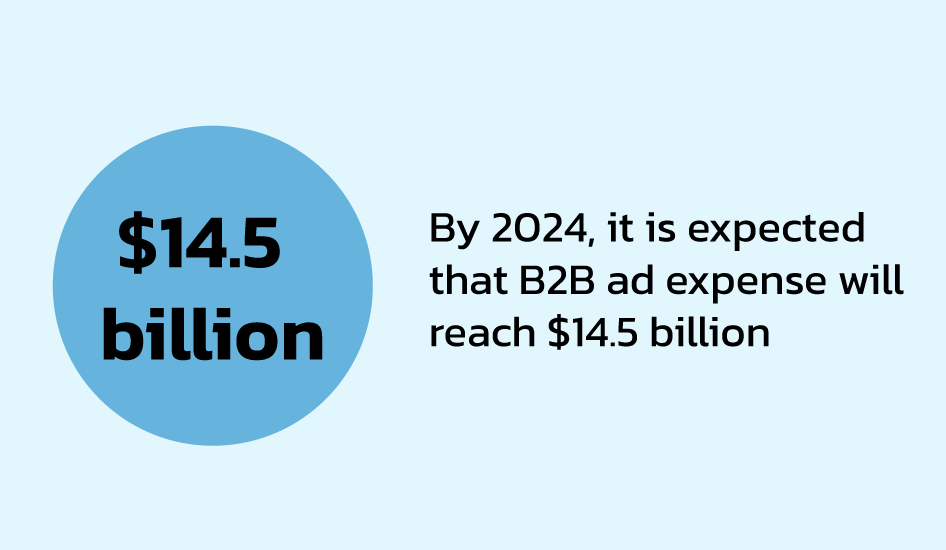
However, projections suggest that B2B digital ad expenses will continue to increase, reaching an estimated total of $14.5 billion in 2024. This anticipated growth represents a strong recovery from the dip experienced in 2020 when spending dropped to $5.56 billion.
Business-to-business (B2B) organizations specialize in selling goods and services to other businesses. Like most others, these companies utilize marketing tactics to reach their target audience and promote their offerings. In this comprehensive introduction to B2B digital marketing, we will explore the definition and nuances of B2B marketing, compare it with business-to-consumer (B2C) marketing, and provide practical tips and strategies for effective B2B campaigns.
What is B2B Digital Marketing?
B2B digital marketing is the art and science of engaging other companies using online channels. Unlike consumer marketing, which targets individual customers, B2B marketing targets decision makers in organizations. The goal is to build trust, demonstrate value, and ultimately drive business decisions that result in long-term partnerships.
At its heart, B2B digital marketing involves:
-
Identifying the right audience: Businesses have specific needs and goals. The key is to understand who in the target company makes decisions and what motivates them.
-
Crafting a compelling message: Information must resonate with the decision maker’s mindset. This means understanding the problems they face and presenting solutions that seem indispensable.
-
Choosing the right channels: Email campaigns, social media platforms, search engine optimization, and content marketing all play roles in reaching business clients.
-
Creating meaningful interactions: The relationship does not end at the first click. Nurturing relationships through follow-up communication builds trust and confidence.
The Psychological Side of B2B Digital Marketing
Human behavior is a powerful force behind decision making. Here are a few psychological principles that guide effective B2B digital marketing:
-
Social Proof: When business leaders see that others in their field are already benefiting from a service or product, they feel a natural inclination to follow suit. Displaying case studies and testimonials is a powerful way to influence decisions.
-
Reciprocity: When companies provide valuable insights or free resources, they spark a sense of obligation in their target audience. This principle increases the chances that a potential client will consider a partnership.
-
Scarcity: In business, the perception of limited availability can trigger a sense of urgency. For example, a limited-time offer or exclusive insight report can prompt decision makers to act sooner rather than later.
-
Consistency: Business buyers tend to stick with choices that align with their previously communicated beliefs. Ensuring that all marketing messages are consistent builds reliability and confidence.
-
Authority: Positioning your company as an expert in your field helps establish credibility. Sharing industry research, thought leadership content, and expert opinions can increase trust and make your messages more persuasive.
By tapping into these principles, companies can design marketing campaigns that resonate deeply with business clients.
The Key Elements of a Successful B2B Digital Marketing Strategy
The core pillars of B2B digital marketing refer to the fundamental concepts that drive effective marketing strategies for businesses seeking to connect with other organizations. These pillars serve as guiding principles for developing comprehensive plans to foster meaningful interactions with target audiences and ultimately lead to fruitful partnerships.
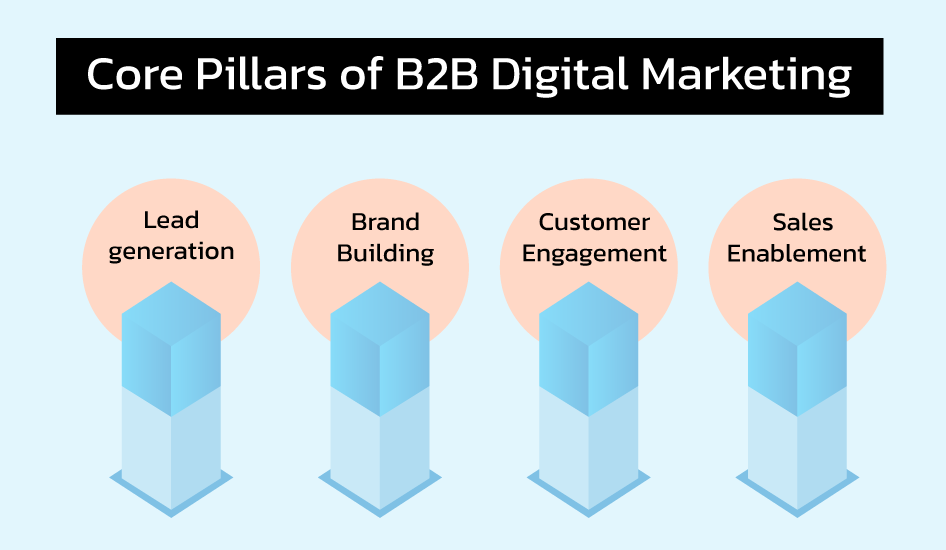
Every effective B2B digital marketing plan contains several core elements that work together to create a seamless experience for business buyers. Let us explore these essential components.
1. Audience Segmentation
The first step in B2B digital marketing is to know your audience. This involves dividing your potential clients into distinct groups based on factors such as industry, company size, role within the organization, and buying behavior. This segmentation allows you to tailor messages that are highly relevant to each group.
Why it works: When potential clients see content that speaks directly to their needs, their engagement levels increase. Personalization signals that your company understands their specific challenges, prompting a deeper connection.
2. Compelling Content Creation
Content is at the center of digital marketing. For B2B companies, content must educate, inform, and inspire action. Think beyond basic information; focus on creating content that solves problems and provides actionable insights. Examples include:
-
In-depth articles and whitepapers: These resources provide valuable insights that can help decision makers understand trends and challenges.
-
Case studies and success stories: Real-world examples demonstrate how your solutions have made a difference for other businesses.
-
Webinars and video content: Visual and interactive content can help explain complex ideas and engage audiences in a more personal way.
-
Infographics: Simple yet effective visual tools that distill large amounts of data into digestible formats.
Psychological impact: Detailed content works on the cognitive bias of authority. When a business buyer sees that you have invested time and expertise into a topic, they are more likely to trust your perspective and view your company as a leader.
3. Multi-Channel Distribution
Today, there are many ways to reach business buyers online. A multi-channel approach ensures that your message is seen by the right people, at the right time, and in the right format. Common channels include:
-
Email Marketing: Direct communication with tailored messages helps in nurturing leads and moving them through the sales funnel.
-
Social Media Platforms: While B2B buyers are not as active as consumers on every platform, LinkedIn, Twitter, and Facebook remain key channels for professional content and networking.
-
Search Engine Optimization (SEO): Making sure that your website and content appear in search results is vital. Organic SEO increases visibility and attracts quality leads.
-
Paid Advertising: Campaigns on platforms like Google Ads and social media can help reach a broader audience and drive immediate traffic.
-
Content Syndication: Partnering with other websites or industry publications to share your content can boost reach and credibility.
Conversion technique: A multi-channel approach employs the principle of consistency. When potential clients see the same message repeated in different formats, it reinforces trust and improves recall.
4. Data-Driven Decisions
Measurement is a cornerstone of any successful digital marketing strategy. Using analytics and tracking tools, companies can monitor the performance of their campaigns and make informed adjustments. Key metrics to watch include:
-
Traffic and engagement: How many people are visiting your website? What pages do they engage with the most?
-
Lead generation: How many inquiries or sign-ups are generated as a result of your efforts?
-
Conversion rates: What percentage of leads turn into paying clients?
-
Return on Investment (ROI): Are your marketing dollars generating profitable results?
Emotional trigger: When decision makers see data backing up claims, they feel more confident about the reliability of your service. Transparency in metrics builds trust and reduces the risk perception associated with a new partnership.
5. Continuous Improvement
B2B digital marketing is not a one-time effort. It requires ongoing analysis, testing, and refinement. A/B testing different messages, experimenting with various channels, and tracking customer feedback can lead to continuous improvements.
Examples of Successful B2B Digital Marketing
In a B2B setting, the customer lifecycle consists of six distinct stages that outline the progression of a relationship between a company and its clients. Each stage requires careful consideration and tailored marketing efforts to maximize the potential for growth and retention over time.
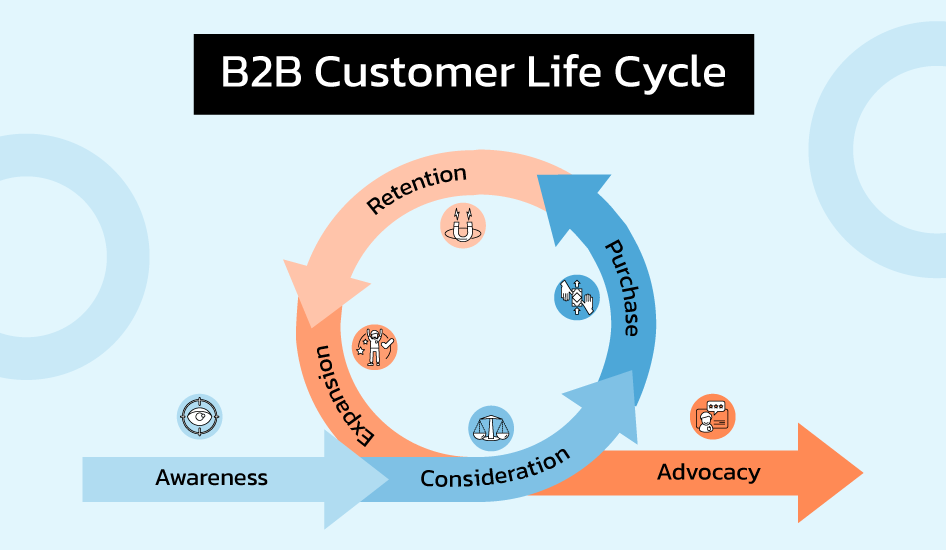
To fully understand the power of B2B digital marketing, it is helpful to examine examples from companies that have transformed their approach through innovative campaigns and a deep understanding of business buyer psychology.
Example 1: Educational Content Strategy
Consider a company that offers business intelligence software. Instead of simply promoting their product, they create a series of in-depth articles and whitepapers that address common challenges in data management. They also host webinars where experts discuss trends in the field. This content does more than educate; it builds a reservoir of trust that decision makers can draw on when evaluating potential partners.
-
Key elements: Detailed guides, expert interviews, actionable insights.
-
Psychological trigger: Social proof and authority. Decision makers see evidence that the company is knowledgeable and well-regarded in its field.
-
Conversion outcome: Higher engagement, increased website traffic, and more qualified leads.
Example 2: Interactive Campaigns
Another firm that provides B2B logistics solutions creates an interactive online tool that allows potential clients to estimate savings and efficiency improvements. This tool is supported by engaging video content and customer testimonials. By providing an immediate, hands-on experience, the company helps decision makers see the tangible benefits of their service.
-
Key elements: Interactive calculators, video content, testimonials.
-
Psychological trigger: Reciprocity and immediacy. Providing a free tool that offers real value creates a sense of indebtedness in the viewer, increasing the likelihood of conversion.
-
Conversion outcome: Stronger lead nurturing and higher conversion rates.
Example 3: Multi-Channel Engagement
A B2B consulting firm uses a multi-channel approach to reach its target audience. They combine email campaigns with content published on professional networks and targeted ads on search engines. Their content is consistent across channels, reinforcing the same message of expertise and reliability. The result is a seamless experience that leads potential clients from initial awareness to final engagement.
-
Key elements: Consistent messaging, integrated channels, targeted content.
-
Psychological trigger: Consistency and authority. Repeated exposure to a unified message builds confidence and familiarity.
-
Conversion outcome: Improved lead conversion and stronger brand loyalty.
Example 4: Digital Marketing in Miami
Imagine a Miami-based software development company wanting to attract large retail chains. Simply cold-calling won’t cut it. Instead, they invest in B2B digital marketing in Miami: publishing case studies about successful retail projects, optimizing their website for relevant searches, and running LinkedIn campaigns targeting retail executives in Miami and beyond.
By crafting content that addresses pain points like inventory management or customer data security, the company positions itself as an expert partner. This approach not only generates leads but also builds confidence in their ability to deliver results.
Differences between B2B and B2C Marketing
Although B2B (Business-to-Business) and B2C (Business-to-Consumer) marketing aim to promote goods and services, several critical differences exist between these two approaches.

Understanding the distinctions allows companies to craft more effective marketing strategies tailored to their target audiences.
Here’s an exploration of some fundamental dissimilarities between B2B and B2C marketing:
1. Target Market
The primary distinction between B2B and B2C marketing is the intended audience. While B2B organizations sell products or services directly to other businesses, B2C firms cater to individual consumers.
Consequently, B2B marketers must comprehend the unique needs and challenges different types of businesses face, whereas B2C marketers often focus on broader consumer trends and preferences.
2.Buying Process
B2B sales typically involve longer and more complex buying processes than B2C transactions. Multiple stakeholders may be interested in the decision-making process, including executives, department managers, and procurement specialists.
Therefore, B2B marketers must convey how their offerings solve specific problems, improve efficiency, or reduce costs within a broader organizational framework. In contrast, B2C marketing often involves emotional appeals, emphasizing product features and benefits that resonate with individual consumers.
3. Communication Channels
B2B and B2C marketing employ varying channels to connect with their target audiences. For instance, LinkedIn remains a popular platform for B2B professionals seeking to build networks, share insights, and promote their expertise.
On the other hand, Facebook, Instagram, and Twitter serve as vital platforms for B2C brands looking to engage with consumers through visual storytelling, influencer partnerships, and user-generated content.
4. Sales Cycle
Given the complexity of B2B buying processes, longer sales cycles are typical. Building relationships and trust with potential clients take precedence over quick closes. This involves multiple interactions, frequent communication, and a deep understanding of customer needs.
Throughout the process, B2B sales reps function as consultants rather than traditional salespeople, offering tailored solutions and value propositions to address specific challenges. During this phase, strong industry knowledge, solution presentation, and negotiation skills remain crucial.
As the sale progresses, B2B reps continually assess customer feedback, adjusting their approach to maximize the chances of securing the deal. Post-sale follow-up is equally important, ensuring customer satisfaction and identifying opportunities for cross-selling or upselling.
5. Technical Support and Customer Service
Regarding post-purchase support, B2B sellers often provide comprehensive technical assistance and dedicated account managers to help clients integrate new products into their existing systems. B2C firms usually have customer service representatives to handle product inquiries, returns, or complaints. The level of support required can vary greatly depending on the type of product or service offered, with B2B customers expecting more advanced guidance due to the specialized nature of their purchases.
6. Brand Loyalty
Lastly, brand loyalty plays a different role in B2B versus B2C marketing. While B2C customers may develop emotional attachments to brands they favor, B2B buyers priorities long-term partnerships based on trustworthiness, dependability, and consistent quality. Brand recognition and credibility are crucial for B2B businesses looking to build enduring client relationships.
In conclusion, although B2B and B2C marketing share some basic principles, several distinguishing characteristics set them apart.
By recognizing these dissimilarities and tailoring their strategies accordingly, businesses can better cater to the unique needs of their respective target audiences and achieve long-term success in their respective markets.
Effective Strategies for B2B Digital Marketing
Now that we have explored the basics and seen some examples, let us focus on strategies that can transform your B2B digital marketing efforts. These tactics combine proven techniques with insights from psychology to create campaigns that resonate on a deeper level.
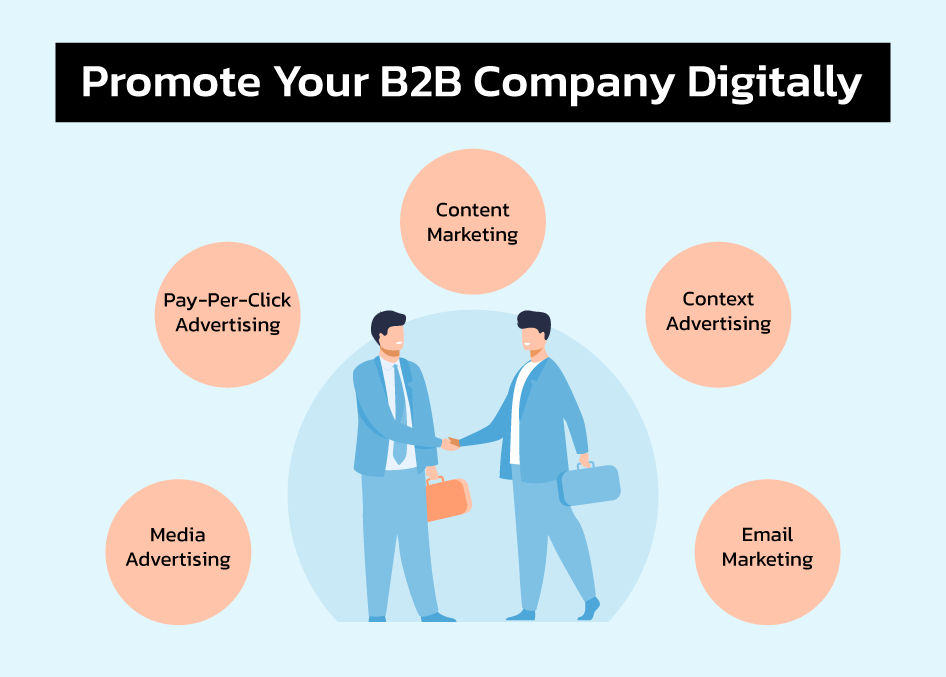
Many B2B organizations have successfully generated leads and strengthened their brands by capitalizing on this platform. Thus, exploring LinkedIn may prove advantageous if you’re seeking to expand your client base or bolster your company’s image.
1. Crafting a Compelling Value Proposition
Your value proposition must be clear and relevant to the needs of business buyers. It should articulate the unique benefits that your product or service provides. This means explaining how your offering solves specific problems, improves efficiency, or reduces costs.
Tips for success:
- Use simple language that avoids technical jargon.
- Highlight real outcomes and benefits rather than abstract ideas.
- Use examples or case studies to illustrate points.
Psychological insight: A well-crafted value proposition works on the principle of cognitive ease. When the benefits are clearly stated, the decision-making process feels smoother and more natural. This simplicity can remove barriers to conversion.
2. Optimizing for Search Engines
SEO is not just about keywords and rankings; it is about making your content easy to find for those who need it most. Start by identifying the phrases and questions that your target audience uses. Then, incorporate these terms naturally into your content.
Tips for success:
- Write long-form content that addresses common pain points and questions.
- Use structured data and meta tags to improve visibility.
- Ensure that your website is easy to navigate and mobile friendly.
Psychological insight: The principle of familiarity comes into play here. When potential clients search for solutions and find your content, they feel a sense of connection. This familiarity makes it easier for them to trust your brand.
3. Personalizing Communication
Email marketing remains one of the most effective channels in B2B marketing. However, generic messages can easily be ignored. Personalizing your emails increases the likelihood of engagement.
Tips for success:
- Segment your email list based on industry, job role, or past behavior.
- Use personalized subject lines that speak to the recipient’s interests.
- Include customized content and offers that address specific challenges.
Psychological insight: Personalization creates a sense of individual importance. When a decision maker feels that a message is tailored for them, it activates the reciprocity bias, leading to higher engagement and conversion.
4. Building Trust with Thought Leadership
Thought leadership involves positioning your company as an expert in your field. This can be achieved through:
- Publishing research reports and detailed analyses.
- Sharing insights through blogs and articles.
- Speaking at industry events or hosting webinars.
Psychological insight: When decision makers encounter high-quality thought leadership content, they experience an increased trust in your expertise. This trust forms the basis of a strong business relationship, making it more likely that they will consider your products or services.
5. Utilizing Social Proof
Testimonials, case studies, and reviews are powerful tools in B2B marketing. They provide evidence that your solutions work and that other companies have had positive experiences.
Tips for success:
- Showcase success stories prominently on your website.
- Use video testimonials when possible to create a personal connection.
- Highlight statistics and measurable results.
Psychological insight: Social proof works by reducing perceived risk. When decision makers see that their peers have achieved success with your offerings, they feel more comfortable making the leap.
6. Employing Retargeting Tactics
Not all potential clients will convert on their first interaction. Retargeting allows you to reconnect with those who have shown interest. By serving targeted ads or sending follow-up emails, you keep your brand in the decision maker’s mind.
Tips for success:
- Use data insights to identify key points in the buyer journey where retargeting is most effective.
- Craft messages that address potential objections or offer additional information.
- Test different formats to see which performs best.
Psychological insight: The mere-exposure effect plays a role in retargeting. The more frequently a decision maker sees your message, the more familiar and comfortable they become with your brand. This familiarity can significantly boost conversion rates.
7. Analyzing and Adapting
Use analytics tools to monitor which strategies work best. Regularly review data on engagement, conversions, and client feedback.
Tips for success:
- Set clear performance indicators and goals.
- Experiment with A/B testing for messages, visuals, and offers.
- Adjust your strategy based on data-driven insights.
Psychological insight: Decision makers are influenced by results and proven performance. When you can show evidence of success through data, you reduce uncertainty and create a more compelling argument for why companies should work with you.
8. Emphasizing Value Over Price
Many business buyers focus on return on investment rather than the initial price tag. Emphasize the long-term benefits and savings that your service can provide. Highlight how your solution improves efficiency, reduces errors, or streamlines processes.
Tips for success:
- Use detailed case studies that quantify savings and improvements.
- Compare scenarios with and without your service to highlight differences.
- Focus on quality and reliability in your messaging.
Psychological insight: This strategy takes advantage of the anchoring bias. By focusing on the long-term benefits rather than immediate costs, you help decision makers see the larger picture and feel more confident in their investment.
9. Developing a Compelling Brand Story
A brand story is not just a narrative; it is an emotional connection that ties your company to the values and aspirations of your target audience. Craft a story that explains why your company exists and how it solves real problems.
Tips for success:
- Be authentic and transparent about your journey.
- Connect with your audience on a personal level by addressing shared challenges.
- Use visuals and narratives that evoke emotion and trust.
Psychological insight: Stories resonate on a deep emotional level. They allow decision makers to see themselves in your narrative, which can be a powerful motivator for action. This sense of identification creates a lasting impression that makes your brand unforgettable.
10. Creating a Seamless User Experience
Your website and online presence must provide a frictionless experience. A well-designed site that is easy to use can significantly influence conversion rates.
Tips for success:
- Ensure that your website loads quickly and is responsive on all devices.
- Use clear calls to action that guide visitors toward the next step.
- Simplify navigation so that visitors can easily find the information they need.
Psychological insight: A seamless user experience reduces cognitive load. When decision makers do not have to search hard for information, they are more likely to form a positive impression of your brand and consider your offerings.
The Road to Higher Conversions
Now that we have examined the core elements and effective strategies of B2B digital marketing, it is time to integrate these ideas into a coherent plan that can drive real results. The following steps provide a roadmap to success:
Step 1: Understand Your Audience
Begin with deep research. Understand the challenges, goals, and motivations of your target companies. Use surveys, interviews, and data analysis to build detailed buyer personas. The more you know about your audience, the more effectively you can craft messages that resonate.
Step 2: Develop a Content Plan
Create a content calendar that outlines the topics, formats, and distribution channels that will be used. Ensure that each piece of content addresses a specific challenge faced by your audience. From in-depth articles and research reports to interactive tools and webinars, variety in content types can cater to different preferences.
Step 3: Distribute Consistently
Implement a multi-channel distribution strategy. Whether it is through email marketing, social networks, or search engine campaigns, consistency is key. Each interaction should reinforce the same core message and build a cumulative sense of trust and authority.
Step 4: Engage and Nurture Leads
Once you have captured the interest of business buyers, it is essential to nurture the relationship. Follow-up communications should provide additional value and address any lingering questions. Personalized emails, retargeting ads, and interactive content are effective methods to keep your brand top of mind.
Step 5: Measure and Optimize
Invest in analytics tools that offer insights into every stage of your marketing funnel. Track metrics such as website visits, engagement rates, and conversion percentages. Use this data to refine your approach, testing different methods and adjusting your strategy accordingly.
Step 6: Build Long-Term Partnerships
Remember, B2B digital marketing is not about one-time transactions. It is about building enduring relationships that result in continuous mutual benefits. Your goal should be to position your company as a trusted partner that delivers ongoing value.
Wrap Up
B2B digital marketing is not a static field. It is an ever-unfolding journey of understanding human behavior and making meaningful connections. The strategies discussed in this article provide a framework that can be customized and refined to suit the unique needs of your organization.
By combining thorough research, creative content, and a consistent, data-driven approach, you can create campaigns that leave a lasting impression on business buyers. Remember that every piece of content, every personalized email, and every interactive tool is an opportunity to build trust and showcase your expertise.
The techniques described here work by appealing to both the rational and emotional sides of decision making. If you want to develop your effective B2B Digital Marketing Strategy, please get in touch with us at +919054331400 or hello@nflowtech.com.

Nevil Bhatt
Nevil is the owner of one of the fastest-growing digital marketing agency in India. Having a great knowledge of the IT field and business management, he decided to bring a revolution in the digital world by providing valuable and customised solutions across the globe. Whether it's real or digital, he knows how to handle sustainable relationships and meaningful interactions.


